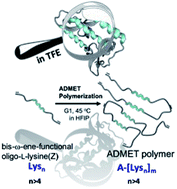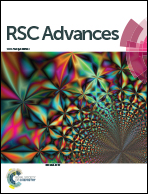Hybrid polymers bearing oligo-l-lysine(carboxybenzyl)s: synthesis and investigations of secondary structure†
Abstract
Hybrid polymers of peptides resembling (partially) folded protein structures are promising materials in biomedicine, especially in view of folding-interactions between different segments. In this study polymers bearing repetitive peptidic folding elements, composed of N-terminus functionalized bis-ω-ene-functional oligo-L-lysine(carboxybenzyl(Z))s (Lysn) with repeating units (n) of 3, 6, 12, 24 and 30 were successfully synthesized to study their secondary structure introduced by conformational interactions between their chains. The pre-polymers of ADMET, narrowly dispersed Lysns, were obtained by ring opening polymerization (ROP) of N-carboxyanhydride (NCA) initiated with 11-amino-undecene, following N-terminus functionalization with 10-undecenoyl chloride. The resulting Lysns were subsequently polymerized via ADMET polymerization by using Grubbs’ first generation (G1) catalyst in 1,1,1,3,3,3-hexafluoroisopropanol (HFIP) generating the ADMET polymers (A-[Lysn]m) (m = 2–12) with molecular weights ranging from 3 to 28 kDa, displaying polydispersity (Đ) values in the range of 1.5–3.2. After chemical analyses of Lysns and A-[Lysn]ms by 1H-NMR, GPC and MALDI-ToF MS, secondary structural investigations were probed by CD spectroscopy and IR spectroscopy in 2,2,2-trifluoroethanol (TFE). In order to study A-[Lysn]ms with defined molecular weights and low polydispersity values (Đ = 1.03–1.48), the ADMET polymers A-[Lysn=3]m=3 and A-[Lysn=24]m=4 were fractionated by preparative GPC, and subsequently analysed by 1H-NMR, analytical GPC, MALDI-ToF MS and CD spectroscopy. We can demonstrate the influence of chain length of the generated polymers on the formation of secondary structures by comparing Lysns with varying n values to the ADMET-polymers with the help of spectroscopic techniques such as CD and FTIR-spectroscopy in a helicogenic solvent.



 Please wait while we load your content...
Please wait while we load your content...